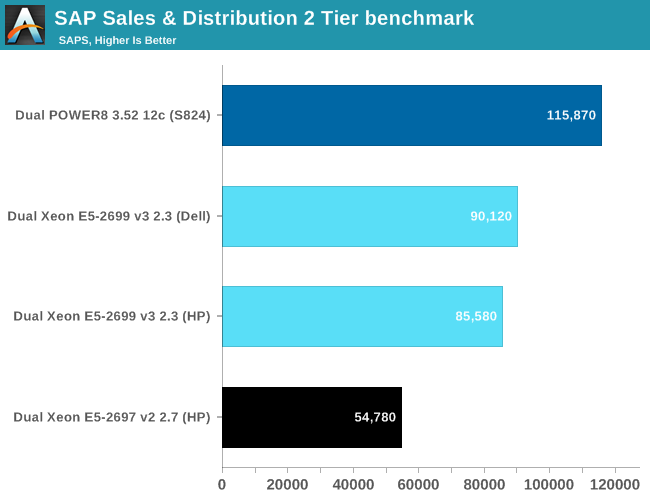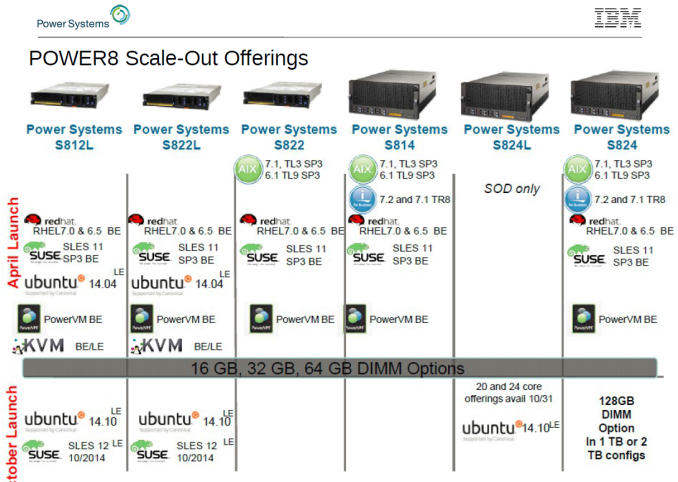The IBM POWER8 Review: Challenging the Intel Xeon
by Johan De Gelas on November 6, 2015 8:00 AM EST- Posted in
- IT Computing
- CPUs
- Enterprise
- Enterprise CPUs
- IBM
- POWER
- POWER8
Reading the Benchmarks
There are a lot of benchmarks available that compare the IBM POWER8 to Xeons. One example is the Enterprise Resource Planning (ERP) software SAP. We have used the Sales & Distribution 2 Tier benchmark many times because it is one of the very few benchmarks that is a very good representation of real world high-end enterprise workloads.

Now combine this with the benchmarks that IBM has compiled on their marketing slides and the fact that we know that the POWER8 chip has a TDP of 190W at nominal speed and 247W when running at "Turbo" clockspeeds.
It all seems very simple: the IBM POWER8 is a more power hungry chip but delivers much better performance. But as always you should take the time to read the benchmarks very closely. The IBM S824 is typically the one featured in the benchmarks. However, we are pretty sure that is not the system that will be able to sway the current Intel Xeon customers towards OpenPOWER. Nor are we convinced that the most widely reported benchmarks are accurately predicting the experience of those people.
There are three reasons for that. First of all, most of the benchmarks are run on AIX (7), IBM's own proprietary UNIX. AIX is a high performance, extremely robust OS, but it does not have the rich software system and support that Linux has. Furthermore even with their common design elements, an excellent Linux administrator will have to invest some time to get the same level of expertise in AIX. But more importantly, the S824 is a pretty expensive machine, both in acquisition cost (starting at $21.000, up to $60.000 and more) and energy cost. That kind of pricing lands the system in hostile and more powerful quad Xeon E7 territory.
Lastly, the S824 uses two CPU cards or Dual Chip Modules (DCM), each containing two six-core POWER8 modules at 3.5 GHz. Now consider that the third party OpenPOWER servers have 190/247W TDP 10-core 3.4 GHz POWER8 CPUs. The power consumption does not increase linearly as you add more cores and higher clocks. So the CPU modules found inside the S824 are definitely more power hungry, probably well above 250W.
There is more. Take a look at IBM "Scale-out" server, the more affordable server range of IBM servers. First, a bit of IBM server nomenclature which is actually quite logical and easy to decipher (take note, Intel marketing).
- S stands for "Scale-out"
- 8 stands for POWER8
- 1 or 2 is the number of sockets
- 2 or 4 is the height, expressed in rack Us.
So an S824 contains 2 sockets in a 4U chassis and a S812 is a one socket system. There is one designation left, : the "L" or Linux .
Notice that the non-L versions also support Linux, but a few months ago they supported only the Big Endian (BE) versions (the slide is from the beginning of this year). IBM told us that all POWER8 servers now support both Little Endian (LE) and BE Linux.
This is important since using an LE version (Ubuntu, SUSE) makes data migration from and data sharing (NAS, SAN) with an x86 system much easier, as x86 only supports LE.












146 Comments
View All Comments
Kevin G - Saturday, November 7, 2015 - link
If all you do is just mount the network volume to use the data, then likely nothing at all. While binaries do have to be modified, the file systems themselves are written to store data in a single consistent manner. If you're wondering more if there would be some overhead in translating from LE to BE to work in memory, conceptually the answer is yes but I'd predict it be rather small and dwarfed by the time to transfer data over a network. I'd be curious to see the results.Ultiamtely I'd be more concerned with kernel modules for various peripherals when switching between LE and BE versions. Considering that POWER has been BE for a few generations and you did your initial testing using LE, availability shouldn't be an issue. You've been using the version which should have had the most problems in this regard.
spikebike - Friday, November 6, 2015 - link
So basically power is somewhat competitive with intel's WORST price/perf chips which also happen to have the worst memory bandwidth/CPU. Seems nowhere close for the more reasonable $400-$650 xeons like the D-1520/1540 or the E5-2620 and E5-2630. Sure IBM has better memory bandwidth than the worst intels, but if you want more memory bandwidth per $ or per core then get the E5-2620.JohanAnandtech - Saturday, November 7, 2015 - link
It is definitely not an alternative for applications where performance/watt is important. As you mentioned, Intel offers a much better range of SKUs . But for transactional databases and data mining (traditional or unstructured), I see the POWER8 as very potent challenger. When you are handling a few hundreds of gigabytes of data, you want your memory to be reliable. Intel will then steer you to the E7 range, and that is where the POWER8 can make a difference: filling the niche between E5 and E7.nils_ - Wednesday, November 11, 2015 - link
Especially if you're running software that doesn't easily scale out very well these are very competitive. And nowadays even MySQL will scale-up nicely to many, many cores.Gigaplex - Friday, November 6, 2015 - link
"Less important, but still significant is the fact that IBM uses SAS disks, which increase the cost of the storage system, especially if you want lots of them."The Dell servers I've used had SAS controllers, and every SAS controller I've dealt with supported using SATA drives. I'm pretty sure SATA compatibility is in the SAS specification. In fact, the Dell R730 quoted in this review supports SAS drives. There shouldn't be anything stopping you from using the same drives in both servers.
JohanAnandtech - Saturday, November 7, 2015 - link
You are absolutely right about SATA drives being compatible with a SAS controller. However, afaik IBM gives you only the choice between their own rather expensive SAS drives and SSDs. And maybe I have looked over it, but in general DELL let you only chose between SATA and SSDs. And this has been the trend for a while: SATA if you want to keep costs low, SSDs for everything else.TomWomack - Sunday, November 8, 2015 - link
And mounting a storage server made out of commodity hardware over a couple of lanes of 10Gbit Ethernet if you don't want to pay the exotic-hardware-supplier's markup on disc.Gunbuster - Friday, November 6, 2015 - link
SAP and IBM AIX servers... I guess if you want to blow out your entire IT budget in once easy decision...Jake Hamby - Friday, November 6, 2015 - link
I forgot to mention: VMX is better known as AltiVec (it's also called "Velocity Engine" by Apple). It's a very nice SIMD extension that was supported by Apple's G4 (Motorola/Freescale 7400/7450) and G5 (IBM PPC 970) Macs, as well as the PPC game consoles.It would be interesting to compare the Linux VMX crypto acceleration to code written to use the newer native AES & other instructions. In x86 terms, it'd be like SSE-optimized AES vs. the AES-NI instructions.
Oxford Guy - Saturday, November 7, 2015 - link
I had a dual 450 MHz G4 system and AltiVec was quite amazing in iTunes when doing encoding. Between the second processor and the AltiVec putting things into ALAC was very fast (in comparison with other machines at the time like the G3 and the AMD machines I had).